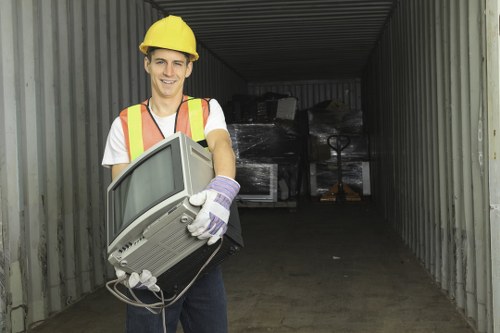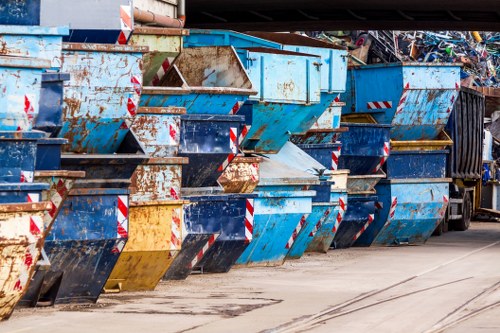Builders Waste Clearance in Council Largeitem Collection

When undertaking a construction or renovation project, managing waste effectively is crucial. Builders waste clearance ensures that leftover materials are disposed of responsibly, keeping the site safe and compliant with local regulations. Understanding council largeitem collection services can simplify this process, making waste disposal both efficient and environmentally friendly.
Builders waste encompasses various materials such as concrete, bricks, wood, metals, and packaging. Proper clearance not only maintains the cleanliness of the construction site but also prevents potential hazards associated with accumulated debris. By coordinating with local council services, builders can ensure that large items are collected and processed appropriately.
Many councils offer specialized waste collection services tailored to the needs of builders and construction businesses. These services are designed to handle large and bulky items that regular waste collection services cannot manage. Utilizing council largeitem collection helps builders stay organized and focused on their projects without the added stress of waste management.

Understanding Council Largeitem Collection
Council largeitem collection is a service provided by local government authorities to handle the disposal of oversized and bulky waste items. This includes items that exceed the size or weight limits of standard waste collection services. By leveraging these services, builders can efficiently remove large quantities of waste without violating local disposal regulations.
Largeitem collection typically covers items such as:
- Construction debris (e.g., concrete, bricks, tiles)
- Old furniture and appliances
- Garden waste (e.g., soil, branches)
- Electronic waste (e-waste)
Each council may have specific guidelines regarding the types of items they accept, the frequency of collection, and any associated fees. It's essential for builders to familiarize themselves with these requirements to ensure smooth and compliant waste clearance operations.

The Importance of Builders Waste Clearance
Effective builders waste clearance is vital for several reasons:
- Safety: Accumulated waste can create hazards on construction sites, increasing the risk of accidents.
- Regulatory Compliance: Proper waste disposal ensures adherence to local environmental and safety regulations.
- Environmental Responsibility: Responsible waste management reduces the environmental impact of construction activities.
- Cost Efficiency: Efficient waste clearance can lower disposal costs and streamline project timelines.
By prioritizing waste clearance, builders demonstrate their commitment to safe, sustainable, and professional construction practices.

Steps to Effective Builders Waste Clearance
Implementing an effective waste clearance strategy involves several key steps:
1. Planning and Assessment
Before commencing any project, it's essential to assess the types and quantities of waste that will be generated. This allows builders to plan the necessary waste clearance services and allocate resources accordingly.
2. Segregation of Waste
Separating different types of waste (e.g., wood, metal, concrete) facilitates recycling and proper disposal. Councils often provide guidelines on how to categorize waste for largeitem collection.
3. Scheduling Collections
Coordinating with council largeitem collection services ensures timely removal of waste, preventing accumulation and maintaining site cleanliness.
4. Recycling and Reuse
Whenever possible, recycle materials to reduce environmental impact and potentially lower disposal costs. Many councils offer recycling programs for specific types of waste.
5. Documentation and Compliance
Maintain records of waste disposal activities to demonstrate compliance with local regulations. This is particularly important for larger projects subject to stricter oversight.

Benefits of Using Council Largeitem Collection for Builders
Utilizing council largeitem collection services offers numerous advantages to builders:
- Convenience: Scheduled collections streamline the waste disposal process, allowing builders to focus on their projects.
- Cost-Effectiveness: Council services are often more affordable than private waste removal options.
- Environmental Impact: Councils typically adhere to strict environmental standards, ensuring responsible waste management.
- Compliance: Using official services helps builders meet legal disposal requirements, avoiding potential fines.
- Flexibility: Many councils offer flexible collection schedules to accommodate varying project timelines.
Choosing the Right Waste Clearance Service
Selecting an appropriate waste clearance service is critical for the success of any construction project. Here are some factors to consider:
Reputation and Reliability
Opt for services with a proven track record of reliability and customer satisfaction. Positive reviews and recommendations can be valuable indicators of quality service.
Service Range
Ensure the service provider offers the specific types of waste clearance you require, including handling large and bulky items effectively.
Pricing Structure
Compare pricing models to find a service that fits within your budget without compromising on quality. Some councils offer transparent pricing, while others may charge based on volume or frequency of collections.
Environmental Policies
Choose services that prioritize sustainable practices, such as recycling and responsible disposal, to minimize environmental impact.
Availability and Flexibility
Ensure the service can accommodate your project schedule, providing timely collections that align with your construction timelines.
Optimizing Waste Clearance for Large Projects
Large-scale construction projects generate substantial waste, making efficient clearance crucial. Here are strategies to optimize waste management:
- Centralized Waste Stations: Establish designated areas on-site for waste collection to streamline removal processes.
- Regular Assessments: Continuously evaluate waste levels to adjust collection schedules as needed.
- Employee Training: Educate staff on proper waste segregation and handling to enhance efficiency.
- Partner with Experts: Collaborate with specialized waste clearance services that understand the demands of large projects.
- Implement Waste Reduction Practices: Incorporate strategies to minimize waste generation, such as precise material estimation and using recyclable materials.
Regulatory Compliance and Waste Clearance
Compliance with local waste disposal regulations is mandatory for builders. Non-compliance can result in fines, project delays, and reputational damage. Here's how to ensure adherence:
Understanding Local Regulations
Each council has specific rules governing waste disposal. Familiarize yourself with these regulations to ensure all aspects of waste clearance meet legal standards.
Proper Documentation
Maintain comprehensive records of waste disposal activities, including receipts and schedules. This documentation is essential for demonstrating compliance during inspections or audits.
Engaging Licensed Disposal Facilities
Ensure that all waste is transported to authorized disposal sites. Using licensed facilities ensures that waste is handled according to environmental and safety guidelines.
Regular Audits
Conduct periodic reviews of your waste management practices to identify areas for improvement and ensure ongoing compliance.
Training and Awareness
Educate your team on regulatory requirements and best practices for waste clearance. Well-informed staff are more likely to adhere to compliance standards.
Environmental Impact of Builders Waste Clearance
Construction activities significantly impact the environment through waste generation. Responsible waste clearance mitigates these effects by promoting sustainability and reducing pollution.
- Resource Conservation: Recycling materials conserves natural resources and reduces the demand for virgin materials.
- Energy Savings: Reusing materials often requires less energy compared to producing new ones.
- Landfill Reduction: Proper waste management decreases the volume of waste sent to landfills, prolonging their lifespan.
- Pollution Prevention: Responsible disposal practices minimize soil, water, and air pollution caused by construction waste.
- Carbon Footprint Reduction: Sustainable waste practices contribute to lowering the overall carbon footprint of construction projects.
Innovations in Builders Waste Clearance
The waste management industry is continuously evolving, with new technologies and practices enhancing the efficiency and sustainability of builders waste clearance.
Automated Sorting Systems
Advanced sorting technologies streamline the segregation of different waste materials, improving recycling rates and reducing manual labor.
Smart Waste Management
IoT devices and data analytics enable real-time monitoring of waste levels, optimizing collection schedules and resource allocation.
Eco-Friendly Disposal Methods
Innovative disposal techniques, such as waste-to-energy conversion, transform waste materials into usable energy, reducing environmental impact.
Mobile Apps for Waste Tracking
User-friendly applications allow builders to track waste disposal in real-time, ensuring compliance and efficient management.
Circular Economy Practices
The adoption of circular economy principles promotes the reuse and recycling of materials, minimizing waste and fostering sustainability.
Cost Management in Builders Waste Clearance
Effective waste management can lead to significant cost savings for builders. Here are ways to manage and reduce waste clearance expenses:
- Accurate Waste Estimation: Predict the amount of waste generated to avoid overpaying for unnecessary collections.
- Efficient Scheduling: Coordinate collections to match project timelines, reducing the frequency of pickups and associated costs.
- Recycling and Reuse: Salvage and reuse materials to lower disposal fees and obtain potential returns from recycling programs.
- Bulk Disposal Agreements: Negotiate bulk disposal rates with council or private waste management services for cost-effective clearance.
- Minimizing Waste Generation: Implement strategies to reduce the amount of waste produced, thereby decreasing clearance needs.
Case Studies: Successful Builders Waste Clearance
Examining successful waste clearance strategies can provide valuable insights for builders. Here are a couple of case studies:
Case Study 1: Residential Construction Project
In a large residential development, the construction team partnered with the local council for largeitem collection. By implementing a waste segregation system and scheduling regular pickups, they achieved a 40% reduction in landfill waste through effective recycling.
Case Study 2: Commercial Renovation
A commercial building renovation project utilized council waste services to manage extensive debris. The proactive planning and collaboration with waste management experts ensured timely clearance, minimizing project delays and maintaining a safe work environment.
Future Trends in Waste Clearance for Builders
The future of builders waste clearance is poised for significant advancements, driven by technological innovation and increasing environmental awareness.
- Automation and AI: The integration of artificial intelligence in waste management systems will enhance efficiency and accuracy in waste sorting and collection.
- Green Building Practices: Sustainable construction methods will emphasize waste reduction, recycling, and eco-friendly materials.
- Decentralized Waste Processing: Localized waste processing facilities will reduce transportation costs and environmental impact.
- Blockchain for Transparency: Blockchain technology can provide transparent and immutable records of waste disposal, ensuring accountability and compliance.
- Enhanced Recycling Technologies: Innovations in recycling processes will enable the recovery of more materials, fostering a circular economy in the construction industry.
Conclusion
Builders waste clearance is an integral aspect of construction and renovation projects, ensuring safety, compliance, and environmental responsibility. By leveraging council largeitem collection services, builders can effectively manage waste, reduce costs, and contribute to sustainable building practices. Implementing strategic waste management plans and staying informed about evolving trends will position builders for success in an increasingly eco-conscious market.
Contact us today to streamline your waste clearance process and ensure your construction projects are both efficient and environmentally friendly.
